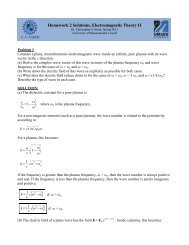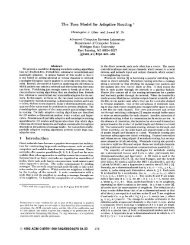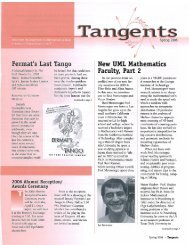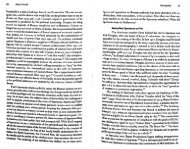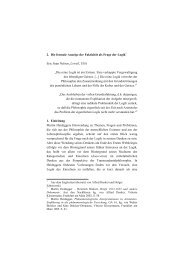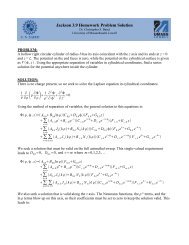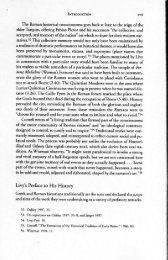167 Paul John Frandsen EGYPTIAN IMPERIALISM* By way of ...
167 Paul John Frandsen EGYPTIAN IMPERIALISM* By way of ...
167 Paul John Frandsen EGYPTIAN IMPERIALISM* By way of ...
You also want an ePaper? Increase the reach of your titles
YUMPU automatically turns print PDFs into web optimized ePapers that Google loves.
342<br />
exposes the suspect nature <strong>of</strong> his claim to the Assyrian throne. Some Sargon<br />
pictures in a temple courtyard 18 show him paired with an unreal<br />
bearded gentleman who could well represent one <strong>of</strong> his earlier namesakes,<br />
the first <strong>of</strong> whom was a dominant figure in early Mesopotamian history.<br />
A final example concerns Esarhaddon, a seventh-century king. He, in<br />
order to fix the succession and avoid civil conflict on his own death, appointed<br />
one <strong>of</strong> his sons crown-prince <strong>of</strong> Assyria, and another crownprince<br />
<strong>of</strong> Babylon. The decision was obviously disastrous. There are letters<br />
to the king praising it, but we can sense the furious opposition <strong>of</strong> more<br />
far-sighted courtiers some <strong>of</strong> whom were probably executed not long<br />
afterwards. Official policy was firmly expressed in stelas, three <strong>of</strong> which<br />
survive. Esarhaddon appears on the front <strong>of</strong> these; on the sides are his<br />
two sons, each in the appropriate robes <strong>of</strong> <strong>of</strong>fice.<br />
The same group <strong>of</strong> stelas employs an unusual convention in showing the<br />
king, Esarhaddon, on a larger scale than his sons; there are also two smallscale<br />
enemies leashed at the king's feet. While there is a parallel in the<br />
Middle Assyrian period, four centuries earlier, the appearance <strong>of</strong> these<br />
small-scale enemies at this moment, just after Esarhaddon's conquest <strong>of</strong><br />
Egypt, suggests that he may have been impressed by the themes and social<br />
perspective <strong>of</strong> Egyptian <strong>of</strong>ficial art. If this is correct, we have yet another<br />
illustration <strong>of</strong> the receptive and practical approach to other cultures<br />
which we find repeatedly expressed in the Assyrian monuments.<br />
These royal stelas are the trademark <strong>of</strong> the Assyrian empire. Their<br />
predominant characteristic, as in the narrative sculptures, is that they<br />
show the king as agent and servant <strong>of</strong> his gods.<br />
We are left then with a picture, a self-portrait, <strong>of</strong> a traditional Mesopotamian<br />
king: this is how the ruler <strong>of</strong> Assyria saw himself and wished us<br />
to see him. There is little explicit recognition <strong>of</strong> the fundamental nature<br />
<strong>of</strong> the change brought about by Tiglath-pileser's conquests. The emphasis<br />
is national rather than imperial, and personal rather than national. The<br />
most significant alteration, perhaps, foreshadowing that Achaemenid<br />
community <strong>of</strong> nations that was already beginning to emerge under Assyrian<br />
dominion, lies in Sennacherib's incorporation <strong>of</strong> Babylonian royal<br />
symbolism into the Assyrian iconographic tradition. This is one case in<br />
which the sculptures, and other archaeological evidence, add substantially<br />
to the information derived from written texts. It is to these, however, that<br />
we must tum for a deeper understanding <strong>of</strong> Assyrian ideology.<br />
NOTES<br />
1. This paper is a slightly changed version <strong>of</strong> that read to the sympO.lium. Footnotes<br />
have been kept to a minimum; there is no satisfactory book dealing with<br />
Assyrian sculpture in general, but essential sources an: included in the list given<br />
by me in Iraq 34 (1972), 112. Most monuments referred to in this paper<br />
are accessible through ReaUexikon der Assyriologie orJ.B. Pritchard, The Ancient<br />
Near East in Pictures. I am indebted to the Trustees <strong>of</strong> the British Museum for<br />
photographs <strong>of</strong> objects in their care, and to Mr. William Wells <strong>of</strong> the Burrell<br />
Collection, Glasgow Art Gallery and Museum, for fig. 11.<br />
2. AX. Grayson,Assynan Royal Inscriptions 11,154-5.<br />
3. E. Unger, Zum Bronzetor von Balawat, Taf. III, Platte P.<br />
4. D.D. Luckenbill, Ancient Records <strong>of</strong> Assyria tmd Babylonia II, 186-8. Luckenbill's<br />
translations, to which I refer below, an: convenient but cannot al<strong>way</strong>s<br />
be relied on; they will be superseded by forthcoming volumel <strong>of</strong> Grayson.<br />
5. Reade, Archiiologische Mitteilungen aus Iran 9 (1976), Taf. 21, 1.<br />
6. Reade, op. cit., Taf. 22, 2.<br />
7. Luckenbill, op. cit. II, 328-9.<br />
8. Luckenbill, op. cit. II, 303, 330-337.<br />
9. Luckenbill, op, cit. I, 211 (Musri).<br />
10. Luckenbill, op. cit. II, 227.<br />
11. e.g, Luckenbill, op, cit. I, 276.<br />
12. The waiters: Reade, op. cit., Taf. 28,2. Quotation from A.L. Oppenheim,journ4i<br />
<strong>of</strong>Near Eastern Studies 19 (1960), 146.<br />
13. Luckenbill, op, cit. 1,288; II, 65 &:c.<br />
14. Grayson, op.cit, II, 197.<br />
15. W. Andrae, Coloured Ceramics from Ashur, pl, 6.<br />
16. Stew and other rock-carvings an: listed by L.D. Levine, Two Neo-Assyrian<br />
Stelae from Iran, 51-58. Supplementary list in Reade, Iranic« Antiqua 12 (1977),<br />
33-44, with discussion <strong>of</strong> the symbolism <strong>of</strong> these monuments.<br />
17. Luckenbill, op. cit. I, 214.<br />
18. G. Loud, Khorsobad I, fig. 104.<br />
343



